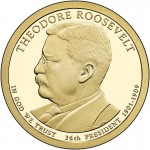 Earlier this month, Sen. Tom Harkin (D-IA) introduced the Currency Optimization, Innovation, and National Savings (COINS) Act (S. 1105) to transition the United States to the use of a one-dollar coin rather than a paper dollar. Harkin introduced the bill with Senators Tom Coburn (R-OK), Mike Enzi (R-WY), John McCain (R-AZ), and Mark Udall (D-CO) as co-sponsors. The bill was assigned to the Senate Committee on Banking, Housing, and Urban Affairs. Only Sen. Coburn is a member of the Senate Banking Committee.
Earlier this month, Sen. Tom Harkin (D-IA) introduced the Currency Optimization, Innovation, and National Savings (COINS) Act (S. 1105) to transition the United States to the use of a one-dollar coin rather than a paper dollar. Harkin introduced the bill with Senators Tom Coburn (R-OK), Mike Enzi (R-WY), John McCain (R-AZ), and Mark Udall (D-CO) as co-sponsors. The bill was assigned to the Senate Committee on Banking, Housing, and Urban Affairs. Only Sen. Coburn is a member of the Senate Banking Committee.
This gang of five appears to have put a lot of thought into the bill in order to try to make the transition more palatable. The first provision of the bill is to remove Susan B. Anthony dollars from circulation within six month. Introduced with much fanfare in 1979 as the first U.S. circulating coins to feature the portrait of a woman, the Susie B.’s were an instant failure when they were mistaken for quarters. They were such a failure, some (alleged) journalists who does not know that the dollar coin was redesigned in 2000 to gristle when thinking of their past experiences.
When the coins are withdrawn from circulation (the bill calls them “sequestered”), they will be available for sale to coin dealers and can be sold to countries that use the U.S. dollar as its currency. Otherwise, these Susie B.’s will remain in legal and withdrawn by the banks when they are deposited. Although the bill does not provide explanation for these provisions, it can only be assume to prevent these coins from causing the confusion we experienced when they were released in 1979.
Aside from the circulation reporting requirements, the section encourages countries that have adopted the U.S. dollar to order coins from the Federal Reserve and for the member banks to only ship dollar coins. However, there are countries that have adopted U.S. currency as its standard that cannot afford the shipment of paper currency and have experienced a shortage of Federal Reserve notes for use in its daily commerce. The switch to coins will make shipping that much more expensive and may lead to a currency shortage in some countries.
As the Federal Reserve “sequesters” SBA dollars, the bill says that the Fed is to start replacing notes with coins but not completely. The bill allows both the notes and coins to circulate concurrently until more than 600 million coins are put into circulation or after four years, whichever comes first. Once the co-circulation trigger is met, the Fed will not be allowed to order currency for one year, thus reducing the supply of the paper note leaving people no choice but to use the dollar coin.
One interesting provision of the bill is that it does not completely eliminate the dollar note. According to the bill, the Fed may produce dollar notes “from time to time are appropriate solely to meet the needs of collectors of that denomination.” Much like the half dollar coin that does not circulate but is included in sets and made available to the collecting community, this will allow the Bureau of Engraving and Printing to produce special sets using one dollar notes in much of the same way they do with the $2 notes today.
A little noticed provision of the bill updates the handling of seigniorage that the U.S. Mint deposits into the United States Mint Public Enterprise Fund (31 USC § 5136). The revision simply allows congress to estimate the value of the seigniorage that will be deposited into the Public Enterprise Fund to be used for the budget process. Without this change, the government can only use the actual value in the account, which is the amount deposited in previous years.
It is probably not lost on these senators that since the Treasury pulled back on the production of dollar coins that the amount of seigniorage has decreased. If congress is going to force the dollar coin into circulation, it will increase the seigniorage the U.S. Mint will collect making those profits a prime target for the government to use for its own purposes. This provision will allow congress to attach those profits before being collected rather than waiting for them to be collected. Although this may not sound right, it is consistent with how congress estimates the collection of tax receipts for the current budgetary process.
Considering my recent experience in Canada using one dollar (Loonies) and two dollar (Toonies) coins, I would like to see this bill passed into law. Given the gridlock that congress has demonstrated by passing only 14 bills to this point of the 113th congress, one cannot be optimistic about congressional action.


This bill is very interesting. At a glance we may think that it is a dumb idea since we are costumed to paper dollars. But this is the way that many other countries print their currencies and many don’t print paper bills until it is $5.00 or more. Mexico starts with their 20 pesos bill which is roughly $2.00 dollars. Everything bellow are coins. I personally would also like this bill to pass.